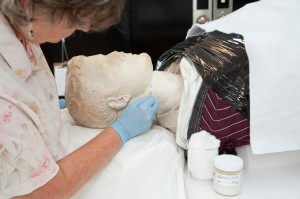
Conservator Amy Byrne works on the head of Caligula as part of the effort to properly realign the sculpture’s head on the torso.
Conservation is one of many essential activities happening at VMFA. While you may be aware of some of the museum’s high profile projects, such as the removal and realignment of Caligula’s head or the discovery of condition changes and intentional artistic alterations in John Singleton Copley’s portrait of Mrs. Isaac Royall in the American galleries, our conservators quietly touch every area of the collection. Their daily tasks vary tremendously—in keeping with the scope of VMFA’s holdings—yet always serve a single goal: preserving 33,000 treasures for future generations to enjoy.
VMFA’s two conservation departments are led by Carol Sawyer, Margaret H. and William E. Massey Senior Conservator of Paintings, and Kathy Z. Gillis, Senior Conservator of Sculpture and Decorative Arts, who together have more than 40 years of experience with the museum’s collection. To properly care for the diverse range of cultures, time periods, and media represented in VMFA’s encyclopedic collection, the museum’s in-house staff periodically contracts with outside experts who specialize in books, textiles, or works on paper.
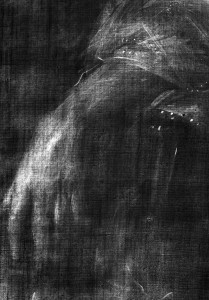
Mrs. Isaac Royall, ca. 1767 and 1777-78, John Singleton Copley (American, 1738-1815), oil on canvas, 50 x 40 in. Gift of Mrs. Adolph D. Williams. A combination of curatorial and conservation work revealed that this portrait was repainted after the sitter’s death.
Evaluating the condition of a work of art, identifying areas of damage, natural deterioration, or alteration, is the foundation of all conservation projects. These meticulous assessments punctuate the life of a museum object: potential acquisitions are reviewed to ensure that they meet VMFA’s exacting standards; works of art are evaluated before being included in an exhibition or loaned to another institution; and returning loans are scrutinized to make sure they have traveled safely. At every stage, the object’s condition is carefully documented and these notes, measurements, and photographs become part of its record.
What the conservators look for during these evaluations varies according to the object—its age, component materials, construction, culture of origin, and evidence of previous conservation treatments. Their judgments are informed by extensive training in art history, studio art, materials science, and chemistry, as well as practical experience. In addition to this unusual blend of talents, conservators bring formidable patience and rigorous attention to detail to what is a slow and painstaking process. In preparation for the museum’s 2010 expansion, which increased by 50% the number of works on view, VMFA’s conservation professionals reviewed every object that would be newly installed and performed treatments on many of them—a project that began ten years in advance.
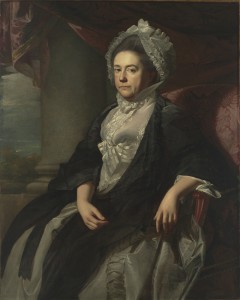
In this second rendering of Mrs. Isaac Royall, the white ruffles of her sleeve and jewelry were painted over. At the same time, Mrs. Royall’s hairstyle was elevated and her costume changed.
A unique perspective
To museum-goers trained never to touch the art, seeing a conservator work with an object is astonishing. Yet they wield this power with the greatest restraint and respect for the original intentions of the artist. Conservators see themselves as part of a long line of caretakers for each object. As much as they look to the past to understand how a work was created and what has happened to it in the intervening years, conservators always act with an eye to the future. Every treatment performed on a work of art is localized to the area of damage and intended to be entirely reversible. Should new materials or techniques become available, subsequent conservators working 50 or even 500 years from now will be able to apply those advances.
In preparation for treating an object, conservators may perform a variety of technical analyses to guide their efforts. With a tool kit that includes radiography, x-ray florescence, infrared reflectography, and microscopy, the conservator’s work is a marriage of science and art. Gillis uses x-ray florescence to distinguish metals that appear similar, such as gold and gilded silver, but which require different treatments. A tiny cross section of a painting’s pigment and ground layers—no bigger than a grain of salt—when viewed under a microscope helps Sawyer understand the pigments and media used, as well as the method of paint layering to achieve a particular effect in the finished work. Technical research can also yield exciting discoveries that enhance our understanding of an artist’s materials, techniques, and working methods. An x-ray of a sculpture’s underlying armature may provide insight into the evolution of an artist’s process, while an x-ray of a painting can reveal “pentimenti” or artistic changes in the composition. Technical analysis is also essential to authenticating a work of art—or exposing a forgery.
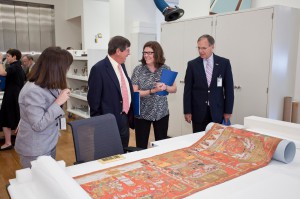
Carol Sawyer discusses her work in the Conservation Studios
with VMFA Trustee Steven Markel (left) and VMFA
Foundation Director A. John Lucas (right).
Once a conservation project is complete and the work of art is ready for public view, the treatment may be imperceptible to the casual visitor. While a new exhibition or educational program may be more visible to the public, caring for the objects entrusted to our care just as surely advances VMFA’s mission as Virginia’s art museum.
A state-of-the-art space for conservation
The David and Susan Goode Conservation Studios are one of the hidden assets of the new McGlothlin Wing. The airy 9,500–square foot suite is flooded with natural light from a long bank of windows that stretch nearly to the 15-foot ceilings, as well as interior skylights. The studios’ design is beautiful and functional, the result of a collaboration between the architects and VMFA’s conservators. In preparation for the long-awaited relocation, conservators Carol Sawyer and Kathy Gillis created an extensive document outlining their requirements for the space —from the placement of “elephant trunks,” the blue fume extraction tubes that snake down from the ceiling, to the studios’ location in the northeast corner of the museum. Indirect, northern light is essential for color matching and cleaning works of art. The combination of windows and skylights ensures uniform lighting throughout the space so that the intensity and color will be the same whether a work is mounted on an easel near the windows or laid flat on a table. Likewise, the flooring mirrors that of the galleries so that the conservators can gauge how the work will look once it’s installed in an exhibition. The high ceilings are able to accommodate traditional full-length portraits and monumental works of contemporary art like those currently featured in Pop Art and Beyond: Tom Wesselmann.
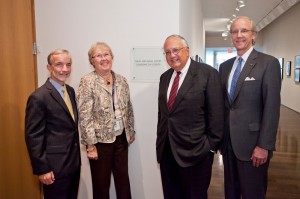
(Left to right) VMFA Director Alex Nyerges, Susan Goode, David Goode, and outgoing president of the VMFA Board of Trustees Thurston Moore outside the Conservation Studios.
On any given day, objects from every corner of the collection can be found in the Conservation Studios—a dazzling illustration of the artistic breadth represented at VMFA. The studios’ reach across the museum was particularly appealing to philanthropists Susan and David Goode, whose love of art is equally wide-ranging. “David and I are so pleased that our gift benefits VMFA’s new Conservation Studios,” notes Susan Goode. “As much as we love visiting particular galleries and returning to favorite works, the opportunity to have a lasting impact on the preservation of the collection as a whole is very exciting.” The couple, who reside in Norfolk, received the Governor’s Art Award in 2008 in recognition of their commitment to the arts across Virginia. Avid collectors of Contemporary art, photography, American, Native American, and pre-Columbian art, the Goodes have been involved with VMFA for many years. Susan currently serves on the Board of Trustees, where she co-chairs the Art Acquisitions subcommittee. The Studios were named in their honor last year in recognition of a generous $2 million gift.
– Sally Curran, myVMFA editor